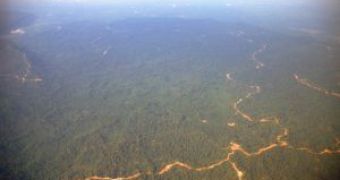The Amazon rainforest is the planet's most biologically diverse community, with up to three hundred tree species occurring in an area the size of just two football fields (as a comparison, in the most diverse temperate forest this variety does not pass beyond 30-50 species).
But this forest is being rapidly felled and fragmented by logging, cattle growing and industrial soy cultivation. Scientists have found that forest fragmentation represents an even greater threat to the Amazonian biodiversity than previously believed.
In a 22 year study, which was the largest and longest-running experiment on habitat fragmentation, they revealed that survivors in various fragments do not stand for long. Since 1980, the team has been studying 40 different one-hectare plots in nine rain forest fragments in central Amazonia near Manaus, monitoring the fate of roughly 32,000 trees composed of 1,162 species, 24 of the hectare plots being situated near the edges of the remnant fragments, while 16 "placebo" samples were deep within intact interior forests.
The researchers focused on 22 different characteristics of the increasing and declining species. They observed that trees communities changed with a remarkable speed in forest fragments. "Rainforest trees can live for centuries, even millennia, so none of us expected things to change too fast. But in just two decades-a wink of time for a thousand year-old tree-the ecosystem has been seriously degraded." explained William Laurance of the Smithsonian Tropical Research Institute in Panama.
Trees on fragment edges were dying nearly three times faster than their peers located inside a forest environment. Microclimate changes near the edges of forest fragments were the main factor behind this phenomenon. "When you fragment the rainforest, hot winds from the surrounding pastures blow into the forest and kill many trees, which just can't handle the stress," said Henrique Nascimento, from Brazil's National Institute for Amazonian Research in Manaus. "Also, winds build up around the fragment and knock down a lot of trees."
The trees that occupy the emptied species are very different. "When you fragment a forest, the winners are common pioneer and generalist species that like forest disturbance," said Laurance. In fact, the total number of tree species did not change in two decades, just the edge species changed radically: from true forest trees to so-called generalist species.
"These species are fast-growth, short-lived species with low wood density," Nascimento explains, "such as Cecropia sciadophylla (photo), which has increased by more than 3,000 % after fragmentation".
The composition of edge fragments is also highly unstable, with one species replacing another rapidly, and the regrown trees are generally smaller than their undisturbed brethren in the interior forest. The biggest losers are true forest trees adapted to shady undergrowth of virgin rain forest which have many links with the rainforest fauna. "The losers are rare, slow-growing tree species that provide fruit, nectar, and homes for a diversity of rainforest animals."
"And when you completely alter something as basic as the trees, the other species that live in the rain forest will surely be affected too."
"In the long term, such wide-ranging disruptions could pose an important threat to tropical biodiversity, given the myriad ecological linkages among rainforest trees and their many dependent animal, plant and fungal species."
"Most vulnerable are trees specialized for living in the dark forest understory that need animals such as birds or bats to disperse their seeds and pollen."
"These changes occur remarkably fast," Laurance insists.
Forest fragmentation could even favor global warming as the small, fast-growing trees contain less biomass, storing less carbon than the true rainforest trees.

 14 DAY TRIAL //
14 DAY TRIAL // 
